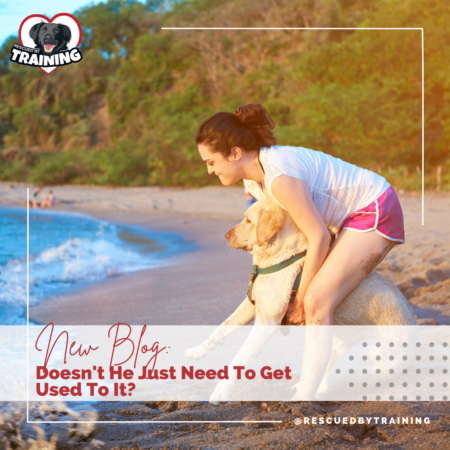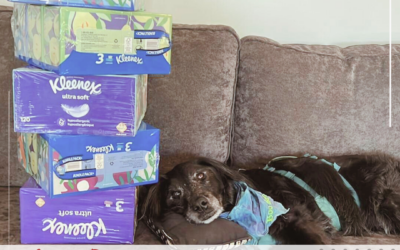I believe all my clients are well intentioned, even if they have been misguided or given bad information. It’s a symptom of this unregulated industry we call dog training. There’s a lot of bad, often wrong, outdated, information that is widely available and promoted, even sometimes by vets, rescues, shelters and those who call themselves trainers. Sometimes people think they are socializing their dogs or helping them overcome fears by forcing them into situations to “help them get used to it” or that the dog will just “learn to deal with it.” Forcing your dog to go on a walk if they’re afraid will not make them less afraid and could actually make them worse. This “sink or swim” mentality – either the dog will learn how to swim and deal with it or sink and fail, is called flooding. It’s the opposite of desensitization, where we break down training into small, manageable, bite-sized pieces, the dog can handle. (My friend over at Eileen and Dogs has a great post, Sink or Swim: 9 Ways You Might Be Flooding Your Dog that is worth the read.) And flooding can, and often does, have disastrous outcomes, making a dog’s fear issues worse, resulting in more generalized fear issues or causing learned helplessness. And, it can affect your dog’s relationship with you. If you put your dog into unsafe situations then you’re no longer a person your dog sees as safe, but rather a person who puts him into scary situations.
When I work with clients I have 6 fundamental rules for living with and training fearful dogs. The first, most important of these rules is this:
KEEP THE DOG FEELING SAFE.
No matter what. If we can’t keep the dog feeling safe, we can’t make progress and we can’t build trust with the dog that we will help them in difficult situations when they arise. We want the dog to know they can look to us to help them get relief when they’re uncomfortable and they don’t have to handle those situations on their own by lunging, growling, being reactiving, biting – that we will read their body language and help do whatever is necessary to give them relieve and make them more comfortable and feel safe.
- Never force a dog into any situation that may make the dog uncomfortable. If you aren’t 100% sure the dog will feel safe, don’t do it. This may require you to change routines like suspending walks, not having people over, adding visual barriers like window coverings, walking at quieter times or using a stroller or car to transport the dog to quieter green spaces or finding other ways to manage the dog’s environment to keep the dog feeling safe. Remember, just because you think something is safe, doesn’t mean the dog perceives it that way.
- Don’t just “test it out” to see what happens. I’ve had so many people push limits because they wanted to “test” the dog and in the process pushed the dog over threshold.
- Don’t just wing it. Follow a structured, incremental training plan. When we do proper training, we follow an incremental plan, deliberately changing different parameters in the plan, one at a time so we can carefully monitor the dog and ensure we’re controlling things as best we can. We don’t just throw the dog in the deep end and hope he figures out how to swim because he was successful standing on the first step in the pool.
As I’ve said many times before, in the US, dog training is unregulated. That means any method including physical pain – choking, cutting off airways, hitting, leash corrections or shocking are all still legal in the US. And yes, sometimes those things can temporarily interrupt behavior because every animal wants to avoid fear and pain. But as I’ve talked about before, behavior suppression is not the same as behavior modification. There is no regulation, licensing or consumer protection in dog training in the US. So there’s very little you can do if your dog gets worse from these antiquated methods. Credentials matter. Read my post of the Muddy Language of Dog Titles here for more detail on credentials. Buyer beware.
If you need help, please reach out for help and let’s make a plan. Schedule your session here!
Happy training!
![]()




